In American society, the common perception of body hair is that it is unsightly and something to get rid of, Yet there are many individuals who prefer the opposite, actually wanting to have more hair growth on a body region of their choice. This attitude may be cultural, or influenced by the collective attitudes held by others, like their peers. For those who do want more hair on the chest, stomach, legs, beard areas of the face, eyebrows, eyelashes neck and pubic regions, body hair restoration ( BHR ) using advanced follicular Unit excision (FUE) technologies like Dr.UGraft may be the perfect answer. To avoid confusion, in the parlance of hair restoration, BHR should be distinguished from body hair transplantation ( BHT) which is when any body hair is surgically transferred from its original body location and implanted into balding areas of the head or any other new location.
Human biases for or against body hair growth are not just regional, they have also shifted throughout history. And now, in more recent years, young adults in the western world are turning the tide against previously held opinions on body hair growth, by accepting their natural hair, no matter how visible it is. Men and women are either growing out their body hair or opting for surgical hair transplantation to acquire it.
Surgical body hair restoration calls for special skills, and use of highly advanced and nuanced techniques to avoid creating unnatural looking hair patterns. Being a cosmetic procedure, the patient often has very little tolerance for poor outcomes giving the surgeon very little margin for error. Using advanced FUE technologies in the hands of a skilled surgeon would make reality the dreams of many young men and women who aim for the natural look of body hair and all it connotes.

Many young adults are adopting a more open and accepting attitude towards natural body hair growth
To Have, Or Not To Have Body Hair – The Influences of Evolution,Biology and Culture
Much like fashion and makeup trends, human perspectives on body hair change due to evolutionary factors, our biology, culture and personal opinions. In fact, these shifts can be traced all the way back, to prehistoric and ancient times.

Body Hair and Evolution
Evolution has significantly influenced our predominant preference of not wanting excessive body hair. It was Charles Darwin who developed the theory that we are descended from ape-like creatures. And our innate tendency to distinguish ourselves from animals has resulted in the sexual selection of women to choose hairless males.
Biases Against Body Hair In Prehistoric and Ancient Times
Archaeologists have discovered tweezer-like tools used by prehistoric humans which may have been used to remove body hair. It may have been the case that this was advantageous for survival, depriving enemies of anything they can use to grab hold of.
Also upper class men in Egypt and Rome saw body hair as uncivilized, using tweezers and blades to achieve bare smooth skin and a more refined appearance.
Cultures That Embrace Natural Body Hair Growth
Throughout the world, tradition and cultural norms have profoundly influenced how people regard body hair.
These perceptions may partly originate from an intrinsic attunement with our own biological processes. Testosterone, which is a hormone that governs male sex characteristics, breaks down into a compound called DHT which causes body hair to flourish. Having more testosterone is equated with masculinity. And the obvious sign of this manly hormone is the visual cue of prolific body hair.
Body Hair, A Sign of Manliness In the Middle East
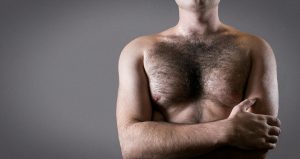
The association between testosterone and masculinity may help explain why Middle Eastern cultures tend to favor full mustaches and dense body hair on the chest. Due to genetic reasons, in most of the population, men tend to have highly visible hair growth in these areas. Having these characteristics can help one assimilate and fit in better within these societies.
Female Pubic Hair, A Cultural Must-Have in Japan
In Japan, women are culturally expected to have full pubic hair growth. It is something to embrace as it represents the transition from childhood into adulthood. The lack of pubic hair, on the other hand, is associated with immaturity.
Also, during the Edo period of Japanese history, prostitutes removed their pubic hair. The average woman in this country is expected to have hair in this region to avoid being thought of as unchaste or promiscuous.
Dr.U explains that “the earliest pioneering work in hair transplantation happened in Japan, way ahead of any other part of the world,” as a result of the immense cultural emphasis for females to have pubic hair. In the late 19th century and very early 20th century, Japanese dermatologists had already performed and published successful cases of pubic hair restoration using head hair donors.
Natural Body Hair and The Controversy Over Gender Equality
In today’s contemporary Western society, shaving and waxing have become a regular part of life for most women Yet, for the average female, these practices are a tedious, time-consuming chore that never seems to end. With many other priorities in work and life, such ongoing routines can be difficult to maintain during the busy course of the week. The rigors of hair removal have prompted growing numbers of women to ask themselves why these routines are even necessary and why they should feel ashamed about their natural hair growth.
When summarizing a 1972 women’s rights manifesto called, Body Hair, The Last Frontier. Vogue writer, Maya Singer explains, “Either you were a shaggy feminist, or you were a pawn of patriarchy, goaded by the pink plastic shaving industrial complex into maintaining a key feminine ideal.”
Media Images Promote Body Hair Acceptance
Fast forward to the more recent years of Generation Z, and we find a resurgence of these feminist sentiments among young adults, giving rise to a newly coined term, “gender fluidity.”
On Instagram, women are celebrating their choice to not bother with hair removal through hashtags like, #hairypits and #hairylegs, with men also posting photos.
Brands like Billie, Aerie and even Nike have launched ad campaigns featuring models with natural body hair growth in areas like the legs, armpits and even pubic regions.
In the world of celebrities, Paris Jackson, daughter of the late king of pop, Michael Jackson, has gone public with her natural body hair. And Madonna’s daughter, Lourdes Lion, also displayed unshaved armpits in public, a personal choice that she may have learned from her iconic mother who did the same.
The generational rebellion against hair removal has sparked headlines like Why Hair Removal Is Now Out of Fashion, where Financial Times discusses how even models are sporting unshaved legs on runways. Vogue published a similar article, entitled, To Shave or Not To Shave, How a New Generation of Women are Embracing Body Hair. It is safe to say that going au naturale with hairiness is not just for hippies anymore, but has clearly moved into the mainstream.
Is the Hairy Male Chest Coming Back?
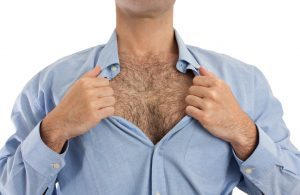
For many years, waxing and shaving the chest have become normative practices for males. And men who don’t like DIY approaches, prefer the help of salons to remove hair from the chest, back, legs and browns.
A 2014 study on college students revealed that both men and women found hairless males to be more sexually attractive [1]. This perspective may help explain why hair removal in men became almost universally accepted.

Now, men too are questioning why they should eliminate chest and body hair, adhering to routines that are time-consuming and oftentimes downright painful. Regular hair removal practices can cause skin issues, like ingrown hair bumps, itching, redness and even bleeding.
Chest Hair Restoration With Dr.UGraft™ Advanced FUE
One of the main advantages of a Dr.UGraft™ procedure for chest hair restoral is that patients can choose the type of hair they want. If appropriate, they can use back hair, as an example. Alternatively, head hair is another option.
Either way, the features of the Dr.UGraft ™ system have been designed to safely extract from on any skin surface with minimal transection. This ensures better survival for the final end results so that patients can then grow chest hair on their own.
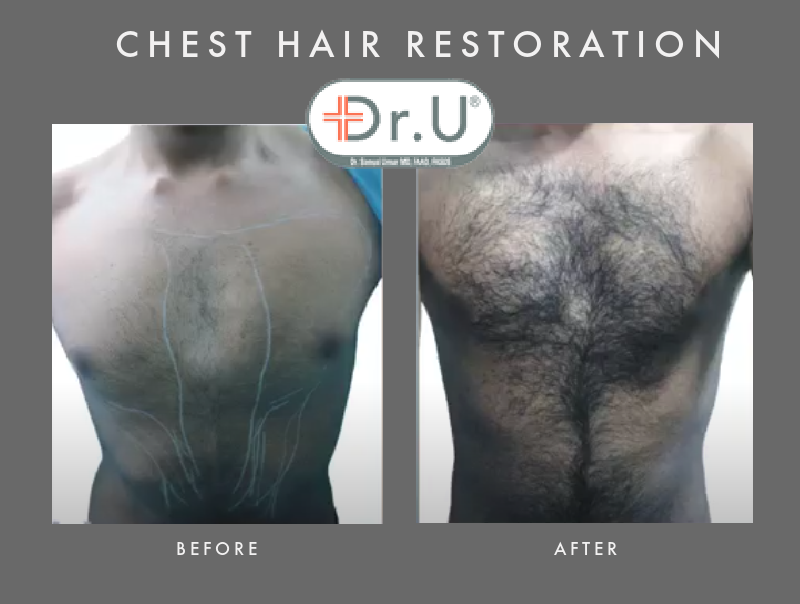
Watch this video as Dr.U explains his approach for transplanting hair on the chest.
Restoring Leg Hair With Dr.UGraft™
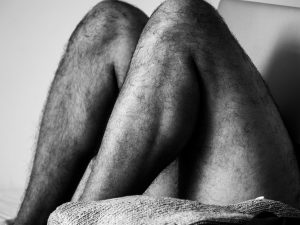
Patients who opt for chest hair restoration may also find it necessary to have comparable matching coverage on their legs as well.
If genetics is a problem for having chest hair, it is likely to be a limitation for leg hair as well, although the role of frictional loss (Traction alopecia) in loss of leg hair from the effect of socks and trousers rubbing against the legs is still a possible factor.
With the ability of Dr.UGraft ™ to remove and transfer hair from any region of the body to another, this would also include leg hair restoration as well.
Choosing Dr. UGraft™ For Pubic Hair Transplant (PHT)

Pubic hair restoration is no longer a most popular choice in Japan. However, this procedure is now on the upswing in Western countries. The recent acceptance of pubic hair has much to do with media influences, as discussed earlier. But also there are many women who no longer can grow hair in this region due to excessive waxing. Now, they are faced with lasting skin injuries that they want to hide. A 2012 study by the University of California revealed that grooming injuries due to pubic hair removal led to a five-fold increase in emergency room visits between 2002-2010 [2]. More women than ever are turning to pubic hair restoration surgery to conceal the skin marks left by aggressive hair removal practices.
Currently, these procedures are being performed with general hair transplant technologies used on balding men. Dr.UGraft™, however, offers a much better option. With this technology Women can actually choose their donor hair graft source, whether the hairs are taken from the scalp or other body region. And secondly, with superior skin healing results, they can pretty much forget they even had surgery to restore their public area in the first place.
Besides the issue of necessity, natural pubic hair growth is now desirable as discussed in major beauty magazines.
In one article, Elle Australia asks the provocative question, “Is the Bush Back?” Likewise, Vogue has declared, “The Full Bush Is the New Brazilian” and provides “Reasons to Give Up Waxing for Good.”
Now that pubic hair is back and surgery can help women restore hair growth in this area, we can reasonably expect that the demand for invasive labiaplasty to decline. Why change one’s anatomy when there is the less painful option of choosing hair coverage for the pubic area instead?
More Natural Looking Beard, Mustache and Sideburn Restoration Outcomes With Dr.UGraft ™
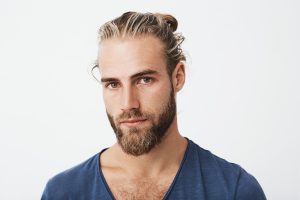
Many men wish to grow out fuller beards, mustaches, and sideburns, but cannot due to genetic limitations. For these individuals, Dr.UGraft Zeus™ makes it possible to transplant any type of hair (i.e. face and/or body) into these facial regions for a natural-looking beard hair restoration. The beauty of this technology is that it offers patients other choices besides scalp hair alone which may produce a more natural-looking final result.
Fuller Eyebrows and Longer Eyelashes
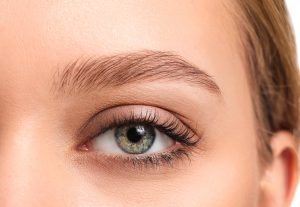
Strong, well-shaped eyebrows are coveted by both men and women. This feature frames the eyes and can have a very positive effect on the overall appearance of the face. Especially these days, it may be quite rare to find anyone, of either sex, who would prefer having sparse (barely their brows) instead.
Having minimal brows can be the result of over-waxing or over-tweezing. And eventually, this leads to permanent non-growth. Many women who are guilty of excessive hair removal in their brows now find themselves wanting fuller looking eyebrows. At this point, surgery is the only way to go.
Dr.UGraft ™ makes it possible for men and women to choose just about any type of hair for their brows. They don’t have to settle for thick scalp hair, which may look out of place. Instead, thin nape, leg and even pubic hair can be repurposed to recreate the eyebrows.
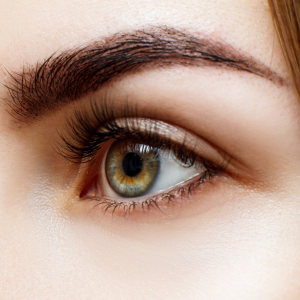
Many women love the look of long eyelashes which can be created through surgery as a more convenient option to false lashes, extensions and prescription medications.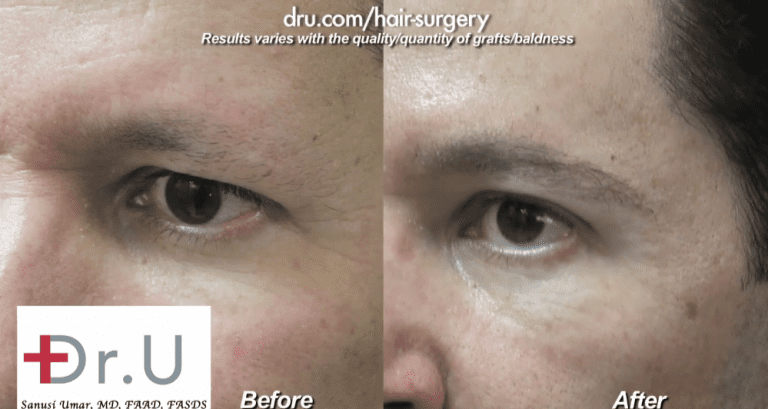
Dr.UGraft ™ technology can be used to transplant nape, leg and other suitable hair types to create thicker eyebrows in men, as well as women.
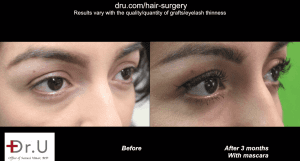
This Dr.UGraft ™ patient represents the world’s first case using leg hair as donor grafts for an eyelash transplant procedure.
Dr.UGraft™, Supports Body Hair Acceptance and Honors Diverse Beauty Choices
We live in a world which consists of many different types of people who uphold different opinions, personal preferences and viewpoints. This diversity is something to appreciate and embrace. Whether a person accepts what they are born with, including their own natural body hair, or whether they choose differently from what their genetics allow, the right to take action on these personal decisions is something to honor. Dr.UGraft™, supports and honors the choices of our patients to decide on the beauty standards they most want for themselves, helping to make their vision a new part of their reality.
References
[1] Susan A.Basow, KatherineO’Neil , Men’s body depilation: An exploratory study of United States college students’ preferences, attitudes, and practices, Body Image, Volume 11, Issue 4, September 2014, Pages 409-417 [2] Allison S. Glass, Herman S. Bagga et. al, Pubic Hair Grooming Injuries Presenting to U.S. Emergency Departments, Urology. 2012 Dec; 80(6): 1187–1191.
Frequently Asked Questions – Body Hair Restoration By Dr.UGraft ™
How does Dr.UGraft ™ technology work to minimize graft transection?
The Dr.UGraft™, system allows practitioners to adjust the rotation behavior of the punch within different skin thickness terrains to avoid damaging the hair follicle graft. Accounting for these differences, rather than relying on a one-size-fits-all rotation is important for safely extracting donor grafts, whether they come from the scalp or other part of the body.
In a Dr.UGraft ™ procedure, how is the placement of the hairs determined?
Hair follicle placement is determined by observing the natural angles, surface densities and orientations of the hair within various regions. Slits are created based on these patterns to produce realistic looking hair growth.
Read More
Discover how this patient of Dr. U was able to achieve the facial hair growth he wanted for himself
Learn how a Dr.UGraft eyebrow restoration changed this man’s appearance for the better.
.
